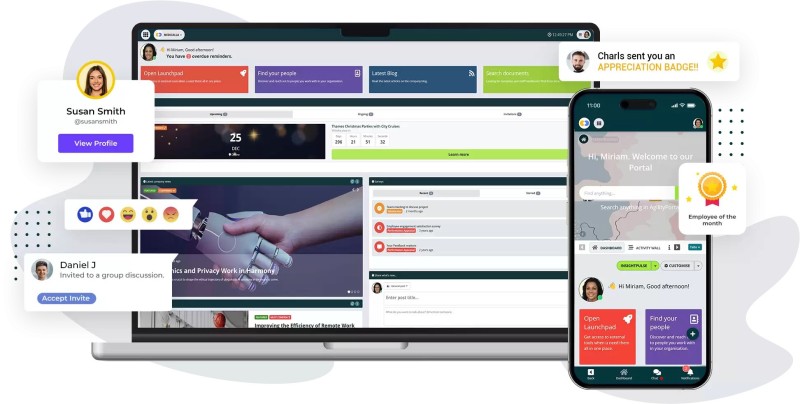Insight Blog
Agility’s perspectives on transforming the employee's experience throughout remote transformation using connected enterprise tools.
14 minutes reading time
(2724 words)
IT Challenges for Businesses with Remote Teams and How to Overcome Them
Hiring remote employees comes with certain IT challenges. Discover how to address each bottleneck to help your business grow.
They say that the people behind your company are the most valuable resources your business can have. In remote working arrangements, the tools they use are just as important.
The continuous growth of the virtual labor workforce opens both business challenges and opportunities.
Unlike traditional setups, this business model increases the demand for network bandwidth and other computing resources. It requires organizations to get rid of outdated technology and step up their digital transformation efforts to manage security risks and their remote employees better.
So, how can you achieve business growth while managing a distributed team?
Read this article: How to Overcome Remote Work Challenges and Managing Workforce Disruptions
The Impact of Remote Work on IT Teams
The meaning of remote work challenges refers to the common obstacles professionals encounter when working outside a traditional office, such as communication gaps, isolation, and maintaining productivity.
The shift toward remote and hybrid work models has significantly impacted IT teams, leading to notable increases in remote IT support demands. Recent studies indicate that 56% of IT professionals have experienced a rise in helpdesk ticket volumes, with 78% attributing this surge to flexible and remote working arrangements.
This increase is mainly due to challenges inherent in remote work environments.Tasks such as hardware procurement and delivery, network security management, and software deployment have become more complex, with employees dispersed across various locations. These complexities introduce issues that were less prevalent in traditional office settings.
Addressing these challenges requires IT teams to adopt strategic solutions that ensure continuous support and enhance efficiency.
Addressing these challenges requires IT teams to adopt strategic solutions that ensure continuous support and enhance efficiency.
Implementing robust remote support tools, enhancing cybersecurity measures, and streamlining communication channels are essential in adapting to the evolving demands of remote and hybrid work models.
The 6 Remote Work Challenges for IT Teams
Working remotely offers flexibility and convenience, but it also comes with unique challenges.
From communication gaps to maintaining productivity, remote workers often face obstacles that can impact their efficiency and well-being.
In this section, we'll explore 6 challenges of working remotely and how to overcome them. Whether you're new to remote work or looking to improve your routine, these tips will help you stay productive and balanced.
So lets get into how to overcome remote work challenges when it comes to IT.
Challenge #1: Increased Cybersecurity Risks
Security breaches remain one of the biggest challenges organizations have to face, whether they have remote employees or not. The difference is that remote setups have more security vulnerabilities because systems are exposed to wider attack surfaces.
Some home networks and mobile devices also have weaker security compared to enterprise systems, making them more vulnerable to phishing attacks and credential theft.
Addressing Cyber-Threats
Cybersecurity leaders often adopt a zero-trust security model in remote settings. This approach hinges on the principle that security threats can come from both inside and outside the organization instead of prioritizing external networks only. Never let your guard down, and always verify before granting access to resources to internal systems.
Apart from intrusion detection systems, use multi-factor authentication for login processes alongside endpoint security measures. Your cybersecurity systems must include antivirus and anti-malware software, firewall systems, endpoint encryption, and network access control, to name a few.
With so many potential issues to consider, it's best to work with an experienced information technology (IT) services provider. Taking this route requires upfront costs, but it can lead to a 40% reduction in business expenses while increasing efficiency by up to 60 percent as per AhelioTech.
Managed IT companies can also help you operate despite major disruptions through business continuity plans.
And its also worth mentioning, they can conduct regular remote employee training on cybersecurity to reduce insider threats and external risks.
Challenge #2: Varied IT Infrastructure Systems
Your in-house systems might be the best there is, but remote workers use different hardware components and operating systems. Even the networks and connectivity levels differ from one location to another.
Legacy systems and outdated hardware, unfortunately, lead to software compatibility issues and affect business productivity.
An unreliable internet connection has the same impact. Software and hardware updates and system maintenance can be great solutions, but the challenge lies in managing these across multiple locations.
Addressing Tech Disparities in Your Team
How about setting company-wide minimum hardware and software requirements, particularly for users who frequently access critical applications? Provide the necessary equipment or issue allowances for internet connection if your company can afford it.
It's helpful to encourage remote team members to use virtual private networks (VPNs) and other secure remote access technologies. As such, IT teams must perform regular maintenance and monitoring to guarantee performance stability and reliability.
Remote work has likewise encouraged widespread cloud computing adoption. With this technology, businesses can improve application performance, storage capacity, and collaboration without significant investments. Integrating it into your current systems, however, requires expertise.
Managed IT service provider Systems-X offers free assessments so your business is at its peak performance all the time.
Challenge #3: Miscommunication and Collaboration Issues
Misunderstandings and conflict can be higher in remote workplace settings because of the absence of non-verbal cues and spontaneous interactions. Relying on digital channels like emails and chats can oftentimes cause delays.
This apparent overload from multiple platforms can sometimes do more harm than good, leading to duplicated efforts and frustration among work-from-anywhere teams.
Different time zones and communication styles can worsen the situation and make it difficult to foster collaboration and teamwork.
Minimizing Team Misunderstandings
This specific problem requires a balance of tools and human touch. First, ask everyone to use the same set of collaboration tools. Make sure that these run on cloud solutions to encourage real-time interaction and have automated backup systems.
Set clear communication guidelines like preferred communication channels for specific type of concerns and the expected response times. Encourage your team to use video conferencing for important discussions and effective communication.
Then, schedule individual check ins regularly to address concerns and improve employee engagement.
The current market for remote workers may be vast, but the skills gap is apparent in some positions. Besides, it's hard to keep a skilled talent unless you know how. It's important to foster employee satisfaction if you want to attract and retain your dream team.
Managing time zone differences is essential for fostering effective collaboration in remote teams. An insightful article by Mallow Technologies, on how to handle timezone differences while working with an offshore development team, provides practical strategies to address this challenge. The article highlights solutions like creating overlapping work hours, optimizing asynchronous communication, and using scheduling tools to enhance productivity. By following these tips, teams can reduce delays and ensure smoother collaboration. For actionable insights and expert recommendations, this article serves as a valuable guide to overcoming time zone challenges in distributed work environments.
Challenge #4: Data Privacy and Compliance Issues
Cybersecurity threats are getting more sophisticated by the day, causing a serious headache for tech leaders.
Unauthorized access leads to costly business disruptions. As of early 2024, the global average for data leaks reached USD$ 4.88 million—enough for most organizations to go bankrupt. If protected networks can be a target of data breaches, so are unmanaged devices.
Unfortunately, managing data access and adhering to data protection laws, for instance, the General Data Protection Regulation (GDPR) and Health Insurance Portability and Accountability Act (HIPAA), are challenging without in-person interactions.
The lack of control over devices and settings can also make handling customer databases and company data more complicated.
Addressing Data Protection and Ensuring Compliance
Establish strict data access controls and the principle of least privilege (PoLP). This security concept aims to minimize the impact of data leaks by providing a user with minimum access to necessary data. Cloud storage solutions, which are often encrypted while in transit and at rest, likewise offer better data protection.
Tech teams should establish clear policies in data handling and avoid employee misuse by getting robust security software for company-issued devices.
As most data breaches are unwillingly caused by exploiting human vulnerabilities, drum up employee awareness of secure network practices and their contractual obligations under compliance rules, if applicable.
Most importantly, IT experts must conduct regular audits to ensure compliance with regulatory standards.
Challenge #5: Delays in IT Support and Remote Troubleshooting
Technical issues bug every business.
The difference is how quickly entities can solve software and hardware malfunctions. In remote settings, though, providing technical assistance and troubleshooting is a challenge because of the distance. You can't diagnose issues effectively without direct access to a user's device.
Screen sharing can be a solution but it's less efficient and time-consuming, leaving virtual employees grappling for solutions.
Managing Tech Hiccups Better
Remote access tools can be a lifesaver in these situations. Using this platform, IT support teams can securely connect to the device in question, even from a distance. As such, it's easier for them to spot and fix the issue.
Larger teams can create a dedicated IT helpdesk or use ticketing systems for assistance requests. They can also provide self-service resources and frequently asked questions (FAQs) that allow users to resolve their issues independently.
Challenge #6: Scalability
The distributed nature of remote teams and the disparities in internet connectivity make it difficult for companies to adapt their IT systems to support their growing team. To ensure consistent connectivity across all locations, many organizations are turning to dedicated leased lines by Elevate, which offer guaranteed bandwidth and stable performance even in high-demand environments. This solution helps eliminate latency issues and provides remote employees with enterprise-grade reliability.
At the end of the day, everything relies heavily on a team member's resources at home, which often have inconsistent bandwidth and latency compared to office environments.
These issues can reduce productivity through slow application performance and intermittent connections.
It's understandable for business owners to prioritize cost efficiency compared to technological investments. Plus, the field evolves so fast that it can be hard to keep up with emerging remote work technologies.
Keeping IT Infrastructure Responsive
Even so, there are several ways organizations can help manage their virtual team members' IT assets. Companies need network monitoring tools to check the performance of critical applications and services their remote teams use.
Then, they can set automatic alerts to identify and address potential performance issues before they turn into serious problems.
Cloud services and cloud software aside, companies can optimize software and network settings to minimize bandwidth usage and latency.
IT teams can likewise improve loading times by tapping content delivery networks (CDNs) to cache frequently accessed content closer to users. Most importantly, organizations must continuously assess IT needs and implement emerging technologies whenever possible.
Solutions and Strategies to Remote Working Complexities
Remote work has transformed traditional team interactions, necessitating the adoption of advanced tools to maintain effective communication and collaboration.
Implementing the appropriate technologies can bridge the gap created by physical distances and enhance overall productivity.
- Communication Platforms - Tools such as AgilityPortal facilitate real-time messaging and allow the creation of channels dedicated to specific projects or topics, enabling swift exchanges akin to in-person discussions. This structure helps in organizing conversations and ensuring that relevant information is easily accessible.
- Video Conferencing Tools - Platforms like Zoom and Microsoft Teams have become indispensable for virtual meetings, offering high-quality video and audio capabilities that support team cohesion. These tools enable face-to-face interactions, fostering a sense of connection among team members despite geographical separations.
- Collaborative Workspaces - Applications such as Trello and Miro provide shared digital environments for brainstorming, task management, and project planning. Trello's visual task management system allows teams to track progress at a glance, while Miro's online whiteboard facilitates real-time collaboration, making complex project planning more manageable.
- Instant Polling and Feedback Tools - Utilizing quick survey tools like Slido and Poll Everywhere enables teams to conduct spontaneous polls and gather real-time feedback. These tools are particularly useful for decision-making processes, allowing team members to contribute their opinions promptly and efficiently.
When developing software policies for remote users, it's essential to standardize the deployment of these tools to ensure employees are operational as soon as their equipment is set up.
This strategic approach minimizes downtime and promotes a seamless transition to remote work environments.
Strengthen Your Remote Team – Overcome Communication Hurdles with AgilityPortal
While remote work offers incredible flexibility and productivity benefits, communication challenges can hinder team performance.
With the right strategies and tools, you can unlock your remote team's full potential while overcoming common collaboration barriers.
AgilityPortal provides the ultimate solution for seamless remote communication with three fundamental features:
- Real-Time Collaboration Hub - Instant messaging, video calls, and project channels keep your team connected and productive
- Engagement Boosters - Peer recognition tools, virtual watercooler spaces, and pulse surveys maintain team morale and connection
- Unified Digital Workspace - A centralized platform that replicates office synergy with document sharing, task management, and social features
Transform your remote work experience with AgilityPortal's powerful platform designed to bridge communication gaps and create a thriving digital workplace.
Say goodbye to isolation and hello to engaged, high-performing teams - no matter where they work!
Wrapping up
The shift to remote work has completely changed how businesses operate and has exposed companies to a unique set of IT challenges. In traditional structures, your tech resources serve as your business's central nervous system.
Imagine having it scattered wider and across different points by having virtual teams. This model compounds the common IT issues faced by traditional companies.
With that said, technology leaders must close the gaps to keep everything running smoothly and securely for everyone.
Solving these tech puzzles is a core component of business strategy and requires more than fixing glitches or addressing common issues and security concerns. Effective solutions for remote setups demand executives to make sure everyone has a reliable and safe digital workspace, no matter where they are.
This is what gets the work done without constant IT headaches.
Frequently Asked Questions (FAQ) About Remote Work Challenges and Solutions
What are the 5 challenges of working remotely and how to overcome them?
The 5 key challenges of working remotely include communication gaps, isolation, time management difficulties, home distractions, and productivity struggles.
Solutions involve structured routines, virtual check-ins, dedicated workspaces, and productivity tools to maintain efficiency.
What are common remote working challenges and solutions?
Common remote working challenges include communication barriers, team disconnection, performance tracking issues, work-life imbalance, and tech limitations.
Effective solutions include collaboration tools (AgilityPortal, Zoom), clear goal-setting, flexible schedules, and reliable tech setups.
What are the challenges of remote working for employers?
Employers face challenges such as low engagement, productivity monitoring, cybersecurity risks, time zone differences, and employee burnout. Strategies to address these include virtual team-building, performance software, secure networks, async work policies, and wellness programs.
How to overcome remote work challenges effectively?
To overcome remote work challenges, focus on proactive communication, digital tools, clear expectations, and mental health support.
Key steps include training on remote best practices, feedback systems, and investing in collaboration platforms.
What is the meaning of remote work challenges?
Remote work challenges refer to obstacles faced in non-office environments, such as miscommunication, loneliness, productivity dips, tech issues, and blurred work-life boundaries.
Recognizing these helps in developing mitigation strategies.
What are the biggest remote work communication challenges?
The biggest remote work communication challenges include misunderstandings, slow responses, over-reliance on text, and weak team cohesion.
Fixes include video calls, clear response guidelines, and open dialogue to improve clarity.
What are the benefits and challenges of remote work?
Remote work benefits include flexibility, no commute, global hiring, and cost savings.
However, challenges like communication breakdowns, isolation, and collaboration hurdles require structured policies and the right tools to balance.
How does the rise of remote work present challenges and opportunities?
The rise of remote work offers opportunities like flexibility, talent access, and lower costs, but also brings challenges such as engagement drops, security risks, and coordination difficulties.
Success depends on adapting policies and leveraging technology.
Read this article: : Top 6 AI-Powered Project Management Tools To Use In 2023
We think you might like to read next

Optimizing the Best Workflow for Remote Teams with Digital Visualization Tools
The modern workplace is evolving rapidly, and digital visualization tools have become indispensable for fostering seamless collaboration. As remote work continues to rise, these tools are no longer just conveniences—they are critical for maintaining connectivity, streamlining communication, and ensuring efficient project management ...
https://agilityportal.io/blog/best-workflow-for-remote-teams-with-digital-visualization-tools
Categories
Blog
(2559)
Business Management
(314)
Employee Engagement
(203)
Digital Transformation
(171)
Intranets
(119)
Growth
(114)
Remote Work
(61)
Sales
(48)
Collaboration
(37)
Culture
(29)
Project management
(29)
Customer Experience
(25)
Knowledge Management
(21)
Leadership
(20)
Comparisons
(5)
Ready to learn more? 👍
One platform to optimize, manage and track all of your teams. Your new digital workplace is a click away. 🚀
Free for 14 days, no credit card required.














